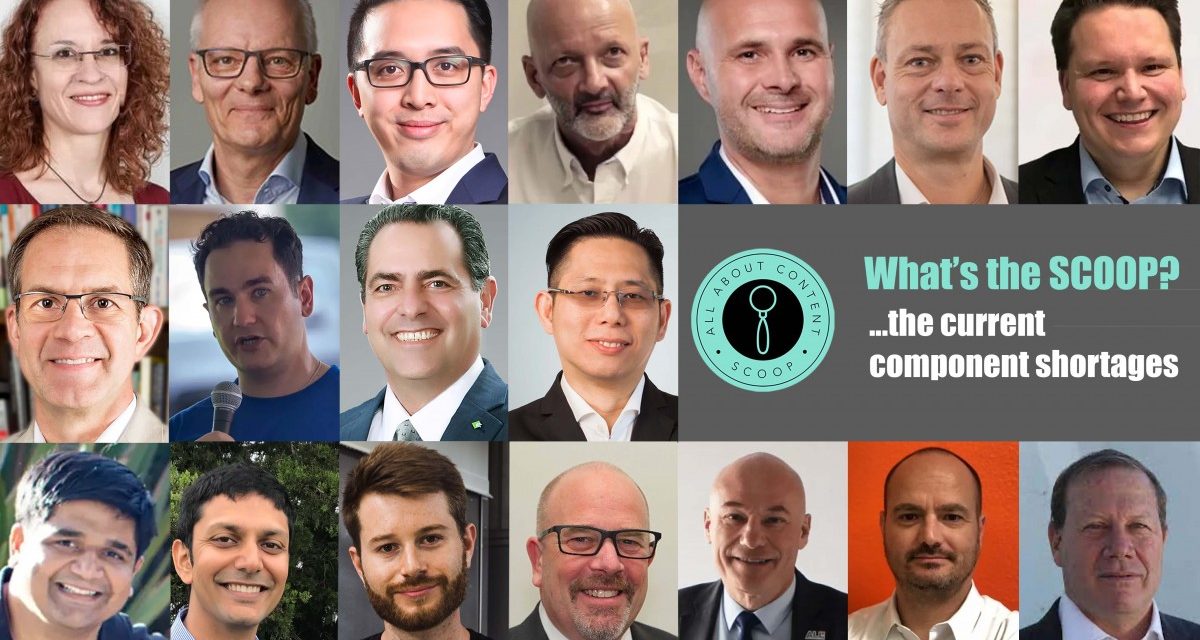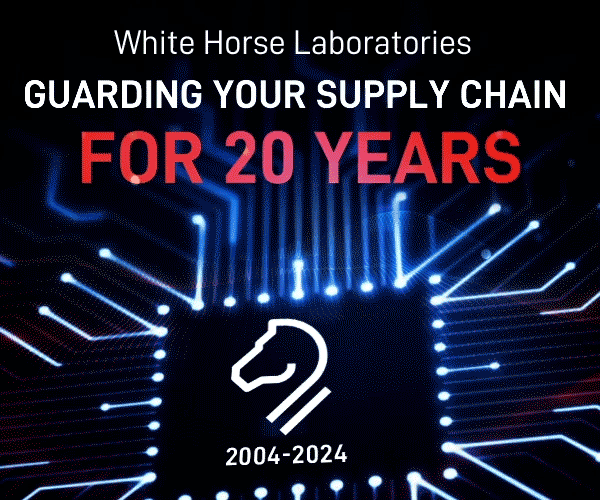What’s the SCOOP – Component Shortage Disruption

By Philip Stoten and the #WTS50
Right now, the biggest challenge facing the industry is shortages in the supply chain. I know right, it’s just one disruption after another! I asked the #WTS50 to comment on how they are impacted by the shortages in the supply chain and how long do you expect this crisis to last? What strategies can help you and your customers? Is there a knock on impact as people start to buy from less known sources, like the risk of counterfeits or out of spec devices, and how can that risk be mitigated or eradicated? And what’s the long term solution, more chip fabs, better supply chain diversity, Design for Disruption (DfD), digital transformation, or something else?
For some background it is worth listening to Fortune’s Leadership Next podcast from June 8th with Intel CEO Pat Gelsinger, who explains, “back in 1990 the US was 37% of world semiconductor manufacturing. Even more startling, Europe was 40%. Today, Europe is 9% and the US is 12%. We’ve seen this historic shift to Asia for semiconductor manufacturing and simultaneously, with COVID, we saw an acceleration of digital infrastructure and a disruption of the supply chain. Now we’re at a position where we essentially have a two year gap to catch up.” I recommend subscribing while you’re there and listening to the recent episode with FLEX CEO Revathi Advaithi on the future of manufacturing.
Also worth a read are two articles from Marco Annunziata in Forbes. Protecting Your Production From The Risks Of Grey Market Devices and Spurred By The Pandemic, Industry 4.0 Is Now Scaling Fast.
So, here’s what the #WTS50 (What’s the SCOOP 50 Most Interesting and Influential) had to say:
Let me say up front this is a lot of information. To make it easier I have grouped the feedback by respondent type, starting with the EMS executives who are probably feeling the most pain right now.
From The C-Suites of The EMS Companies

GPV has launched several initiatives to mitigate the effects of the current global shortage of materials and the ensuing logistical challenges. On a weekly basis, executive management meets with the local management teams at the group’s largest sites to support and facilitate steering, share knowledge, and to coordinate how to distribute the scarce resources of materials and capacity as optimally as possible.
GPV is also successfully supporting the redesign of products. If a product cannot be produced due to a lack of materials, GPV helps with the redesign and production of a customer’s products or introduces alternative components in close collaboration with customers. When successful, this gives the customers a significant competitive advantage:
We’re currently in a situation where our customers are often forced to think about redesigning specific components because of the material supply situation. When that happens, we help them redesign or find full-fledged alternatives and available components so we can secure production. In short, when we reduce one of our customers’ current biggest challenges, this reflects positively on us in terms of goodwill and growth,

We are trying to make sure that our customers don’t increase their short term demand within lead-time. And we have added more purchasing resources to immediately catch opportunities to buy components on the open market, and propose alternate components when feasible. Occasionally we have to buy components from brokers but we have our own process to detect counterfeits before using those components in production. It’s clear that the situation is encouraging some brokers to take advantage of the issue, but we don’t take any risk
Personally, I believe that more chip fab capacity and good design for disruption (DfD) are the only way we can avoid this situation lasting or recurring.

For now, order books are at record levels, and our financials are strong, but clear-to-build (CTB) is much harder to achieve with shortages in certain components. To manage this supply-side problem, our strategy has been framed by the following 3 points of focus:
- Maintain open and transparent communication channels with our customers. In such a volatile market, it has never been more important to maintain a regular flow of accurate information with our customers. Any changes in the market environment can be instantly discussed so that the most rapid and appropriate response can be made. In these times, speed and adaptability is key!
- Turn to Design for Disruption (DfD). One way to get around supply chain disruptions is to be creative and smart about it. Our design engineers use their expertise to help customers manage lead times and development costs by making design adjustments. The original functional design of products can be maintained even if different components or materials are used. That’s the beauty of the DfD solutions that are available to our customers.
- Maintain strategic relations with vendors and quality of supplies: we source our materials only from trusted sources to safeguard the quality standards of the products we manufacture for our clients. When faced with such a shortage in components, it is possible that the quality of components in the market may be compromised at times. As such, having a strong IQC (inbound quality control) system in place is a top requirement to ascertain the quality of our supplies. Performing Design for Testability (DfT) analysis can also make sure there is proper test coverage for our products.
Whilst the supply-side recovery may be slow, I have faith in the market sorting itself out in the long-run. It is simply a matter of time and our ability to withstand the challenges that emerge along the way. Our objective to be adaptable, open, transparent and reliable partners for our customers remains unchanged. Let’s weather these difficult waves together!

- Higher component prices and exceptional freight costs cannot all be billed to the customers. This is a hard battle we need to fight everyday to protect our company. And this speaks to the importance of a close, open and honest relationship between brands and their electronics partners. We are mutually dependent, so we should support each other as much as we can.
- We are shipping lower volumes at lower margins than expected. And these volumes are far below the customer demand, all because we have unexpected missing parts almost every week. The lack of predictability is hurting as much as the lack of components.
- We are also seeing exploding working capital demand with negative cash flow as we often have to order and pay 100% of the parts for a module, only to find that one part is not delivered, so we can’t produce the module and 99% of the parts become stock or WIP (work in progress).
We have a mixed task force of procurement, sales and logistics dealing with the situation daily. And we try to be as flexible and agile as possible, sometimes this means that in one location our employees do not know whether next week they will have short time work or they have to work overtime, and this is very difficult. But maybe most important is the continuous communication and 100% transparency between our customers, suppliers and us. No hidden agenda, no overstating of demand, no finger pointing.
Sometimes with some creativity we get access to missing parts from “less known sources”. We then discuss this openly with the customer to ask whether they are supporting this solution. If not, we don’t do it.
Design for disruption is also a solution. Knowing there are alternatives for critical parts in advance can certainly mitigate risk. Also long term demand commitments from our customers and long term visibility of volumes over, say the next 48 months is extremely helpful.
Rainer Koppitz concludes, “ honestly, all of this doesn’t help so much in a situation like this. If there are no chips, there are no chips, full stop! And then some sort of Wild West happens – and after the big shootout we will see who survived…”

The semiconductor industry is not a fast moving sector and while we have had a flurry of announcements we will not have an immediate benefit from those projects. We fully expect this crisis to last well into 2022.
We have well developed digitally enabled supply chain systems and these have come to the fore. We have doubled and doubled again our efforts to procure all the parts we need, leveraging the great relationships we have developed over the last decade or so. We have also doubled our efforts in terms of supply chain traceability, goods in inspection, inline inspection and much more. This crisis is an opportunity for some bad actors to take advantage, so we need to be even more careful. We have robust systems to ensure that every component that gets to the line is genuine, in spec and has been properly stored and delivered.
I have talked at length about a European Manufacturing Renaissance and I would hate to think that a supply chain disruption like this could slow this renaissance. We need to think long and hard about every part of the supply chain, where it is and how we can secure it.

We currently expect the situation in the area of passive components to relax mid- 2022 and in the active component area not until the end of 2022/start of 2023.
Long-term, stable demand planning is critical. We must be able to transmit demand numbers for at least 12 months and even better 24 months. This is best accomplished with logistic connections though delivery schedules (CMI & VMI). Most critical is that suppliers with very long production lead times, 120 days or more, like semiconductor manufacturers, have long-term and plannable transparency. “Pipeline is King”.
On the other hand we need to rethink warehousing due to the constant disruptions in the global supply chain and build in more security, which in the end also means more flexibility. We used to say “Cash is king”, but today the motto is “Stock is king”.
Counterfeits are indeed currently a hazard. Therefore it’s very important to check sources. Zollner Elektronik AG has four partners it exclusively uses. They check whether ERAI and GIDEP sources are compliant. Additionally they ensure components are IEDA certified with the help of a receiving inspection.
Currently extensive funding is going toward expansion of semiconductor fabrication. In the next two years construction will begin for 29 wafer fabs (19 by the end of this year and 10 in 2022). Most of them are in Asia but 3 are also in Europe.
The entire supply chain needs to be more heavily digitalized to bring more transparency into the supply chain. Here digital transformation will be a great aid, together with AI. We already have very good transparency in our supplier network and partners at our side who have taken over warehousing for us and are able to supply us at short intervals.
Beyond that, the setup of long-term and stable supply chains and partnerships with component manufacturers and distributors will become key to a stable supply situation.

We recognise that we cannot solve the global chip shortage. However, at the end of the day, all we really care about is getting things made for our customers, even in times of crisis. This is what saw our customers through the pandemic and this is what will see them through this crisis.
What’s been working for us so far is a combination of approaches, including but not limited to dual sourcing, better inventory planning, and stronger relationships with our trusted suppliers. Regardless of the complexity of the problem, the greatest tool in our risk management toolkit has always been transparency with our customers, our suppliers, and our partners.
“Our factory is our customers’ factory. We always encourage our customers to work beside us, talk to us as if we were their production team, and don’t hide anything. That’s the added value we provide,” says Charles Tonna, the Executive Vice President at Microart Services.
As it usually happens during challenging times, there are bad actors that try to take advantage. The semiconductor chips shortage and supply chain issues have created fertile soil for fraudulent suppliers. It’s now even more important for OEMs and their manufacturing partners to buckle up and maintain strict counterfeit detection and prevention measures.
We leave no room for compromises when it comes to identifying fraudulent or sub-par items. We have strict counterfeit detection and prevention guidelines in place and have already developed a gut instinct for this type of issue thanks to years of experience.

In each of our facilities we have created a material shortage task force with group oversight. We are trying to select the escalations as early as possible to react quickly with solutions like second sources, availability checks in global markets, re-design proposals, all to serve our customer on time. And of course we step in at group level in those escalations with manufacturers and our suppliers to get at least some allocated minimum quantities for our sites.
We are aware of additional risks like counterfeits, out of spec devices etc. We have secure supply chains and incoming quality control and keeping the customer into the loop to manage the risk as low as possible. Until now we have been lucky and have had no issues, but vigilance and open collaboration continue to be our watchwords.
From a sourcing perspective we definitely need more second sources approved by customers to have more availability options in the market. Longer planning horizons by customers (as a standard, not only in crisis) are also a good solution. And by long term we mean up to 12 months and beyond. Chip fabs need to be more in line with the global demand which has increased as a result of mega-trends. Digitalization will help for early warnings and will create additional visibility in managing supply chain disruptions.

BMK knows how to handle itself during a crisis. Since last summer, we have been working through this predicament with the assistance of our long-term manufacturer and supplier strategies. We can make quick decisions and adapt well to the constant changing issues due to our close and direct customer connections. Our purchasers are not unevenly dispersed across many areas, but rather they are focused in one location. Our lead buyers always have an eye on the market and are networked very well with one another. Our transport management team is a huge benefit for us and provides an absolute advantage for reliable shipments. Despite everything, the situation remains very challenging for us and the whole EMS business. With each passing month, the circumstances become even more arduous and will demand a lot from us throughout the remaining year.
During shortages there could always be free riders wanting to make money. The less parts available, the higher the risks. We work together with approved and reliable suppliers. If no other validated and trusted sources are obtainable, then we use our strict procedures for incoming inspections and extensive testing to check for anything suspicious. We also stay in close contact with our customers throughout this process. Our manufacturers are also very helpful by checking trace data.
A single solution will not help. A combination of changes is needed. Asia is the leading market for electronic components and many manufacturers had to transfer their fabs to Asia because the pressure from competitive pricing in Europe and in the US was too large. A new manufacturing site cannot be built in one month. When Asian manufacturers shut down due to winter storms, tsunamis, or earthquakes, this can bring the entire supply chain to a halt.
Therefore, Europe needs more chip fabs and shorter delivery channels. We help our customers by finding the best matching parts, manufacturers, and supply chain ideas for their products. If single sourcing cannot be avoided, then risk assessment and management must be thought about before starting series production. Growing digitization can help maintain a variety of information through intelligent solutions.

Visibility of demands is key in this market, a stable and long term backlog to share with suppliers for demands gives the best opportunity for getting parts on time. Also, having multiple suppliers on an approved vendor list helps when searching for stock or if one supplier has lead times pushed out.
There is always a risk from buying from brokers or non-franchised suppliers, parts might work early on in test and fail in the field or in a higher level assembly which would be more costly to diagnose and potentially scrap. Also, manufacturers will not offer support on components not purchased through franchised distribution. The non-franchised market can be tempting when you are seeing stock on a very long lead time part. If there was a way for manufacturers to obtain this stock from the market and recertify it to be sold though franchised channels, it could help mitigate risk of counterfeit parts.
There is not a one size fits all solution. We see these ups and downs in the electronics market every few years, so even this current condition is not completely new to the industry. One thing that would help is if, when companies are designing and revving up assemblies, they have multiple sources. Keeping up with the latest technology generally helps with supply. More often than not you see the older technology parts being phased out with price increases and longer lead times as manufacturers shift capacity to newer parts that are more profitable for them to manufacture and have higher overall demand. As we learned in the 2018 allocation market where MLCC were highly constrained, older and larger package sizes like 1206 and 0805 were harder to source as manufacturers focused on the newer 0402 and 0201 sizes which would yield more parts, thanks to the smaller sizes.
From The Companies Supporting the EMS Industry

After all, we can’t just build semiconductor fabs at the drop of a hat – it takes a long time and costs billions. The market faces an unbalanced situation where some companies stockpile and make a good profit. The supply chain cannot stay “clean” when there are so many opportunities to make a nice profit, and it is probably here to stay.
But worse than no components are fake components or components that are not fit for purpose. And while lab or batch testing of incoming parts is a good start, it will not provide the whole picture. It’s like trying to test the entire population of the US for COVID every day.
The industry can only mitigate the problem with a ‘Zero-Trust’ complete traceability approach. Zero-Trust is already adopted at the software level but not yet at hardware. It only exists when every part is inspected and becomes part of the industry’s typical routine. According to CPO Magazine, “Zero Trust Manufacturing Approach Key to Balancing Complex Supply Chains and IoT Device Security”
Cybord customers are feeling a little smug right now with the real-time component inspection system they are running. Some are using our software to inspect components as they come into the facility using a custom piece of reel-to-reel equipment. This is ok as long as your gray market content is low. But most are using the software, which interrogates the images taken by the placement head on the line, identifies counterfeits, damaged, old, or incorrect parts immediately, and provides granular traceability that drive process and performance improvements.
Customers from both the OEM and EMS sectors see this “every single part inspected” solution as the only way to mitigate the risk of buying on the open market.

We’ve seen many of our partners in the industry quoting longer than normal lead-times, leading to delays in their ability to manufacture and deliver product. Two strategies have proved important in navigating all of this. One, when our manufacturing team has down time, we are very intentional about using that time to identify opportunities to improve our efficiency and implementing those changes. Two, as we experience the difference among our vendors in their efforts to communicate order status, we are reminded of the value to our customers of providing regular and reliable information regarding their orders.
For all the challenges these days, sales growth has been remarkable. That growth has been evenly distributed across the industries we serve, with one exception. While demand has increased among SMT manufactures, medical device manufacturers, and others, the one real spike we have seen is among electronics component distributors. It stands to reason, as independent distributors are on the front lines when it comes to combating counterfeit components. With the severity of the semiconductor shortage, there has been a corresponding surge in counterfeiters attempting to fill the void. With our experience in pioneering the use of X-ray inspection in counterfeit component detection, we’ve been well positioned to help these distributors.
An interesting trend we see, and I think we can attribute its acceleration to the pandemic, is increasing interest in automated and especially autonomous solutions. Incorporating cobots, robots, and artificial intelligence algorithms have, until recently, been the less common features of customized systems that we count among our specialties. But because autonomous systems don’t have to suspend production when they get the sniffles (or they’ve been exposed to someone with the sniffles), they are becoming a hedge against the uncertainties of the times in which we live. In some ways we are just having to adapt to an environment in which custom may become our new standard.

We are believers in digital transformation, harnessing data and using inspection as the core of reliability and traceability. All of these solutions can be leveraged in such a crisis. Digital transformation of all business and manufacturing processes offers great benefits in terms of visibility and agility. Data provides intelligence in the manufacturing ecosystem that can help make faster and better decisions. And inspection has a huge role to play, especially when parts are coming from non-standard sources.
The current market is very tempting for those with criminal or bad intent and inspection is one essential safeguard to ensure any part that gets to the line is not a counterfeit, is within spec, and is fit for purpose. 3D optical inspection on the line can help ensure that every part placed is the right part and is soldered correctly. If a component has not been stored well and as a result the solder doesn’t flow properly, AOI is the first line of defense.
In the long term, a digitally enabled, connected ecosystem with inspection in multiple locations will lead to better outcomes and greater confidence that the parts on the line are what they should be. As for the supply chain, that same digital transformation and real time data driven approach will improve outcomes and provide adaptability and resilience.

This kind of disruption is one of many reasons we believe so strongly in a future where real time data and autonomous software drives supply chain and manufacturing decisions. A future where entire supply chains operate autonomously has the potential to completely avoid, or at the very least reduce the impact of these supply chain disruption, which seem to be becoming the norm. Imagine a world where data and software had been able to predict demand more accurately and would have been able to provide investment and capacity expansion signals well ahead of time.
There is no doubt in my mind that those with a digitally enabled supply chain have and will continue to cope better with these disruptions, but even more can be done to ensure the world of manufacturing is more adaptable and more resilient. And at the same time more efficient and more profitable.

Supply chain professionals feel the pain of inefficient processes at a higher level during a limited availability market. This is why CalcuQuote has been so driven to create a product suite that automates the sourcing process, allowing supply chain professionals to focus their time on what matters. With an automated approach to quoting (QuoteCQ) and purchasing (ShopCQ), CalcuQuote has become increasingly necessary for supply chain teams amidst the current climate of industry shortages.
Being proactive is key, but given the current climate, the best thing to do right now is improve efficiency. Automation can reduce the amount of time spent searching for and ordering components, and more available time means more resources to work closely with supply chain partners in this chaotic market.
From The Movers and Shakers in the Supply Chain World

One cannot control the macro economic impacts of a disruption. But one can certainly run what-if scenarios and make data-driven decisions to mitigate the impacts on business during such a crisis. Time and again we have seen ‘what-if’ questions come up when making decisions and most times the answer is a guess or an opinion or a bias or a mix of all these. Secondly, a data-driven answer often takes days or weeks to get. ‘What-if’ analysis capability enabled by software provides a data-driven, rapid, decision support framework. Augmenting human intelligence with software tools provides the competitive advantage at 10X speed of others in your industry.
Digitalization is driving exponential increase in data size and global supply chains need faster and smarter answers. Every action and reaction in supply chain operations generates data. Supply chain planning and execution with spreadsheets is simply unsustainable in this era. As companies digitize this data it is imperative to implement tools to extract, analyze and collaborate this data to unlock the potential across supply chains and deliver a superior brand experience to customers.

Starting with the materials that come out of the ground, everyone has a role to play. There needs to be a focus on mining raw materials, where and how! There needs to be a focus on the conversion of those mined minerals to the materials that industry uses, again where and how.
The U.S. Interior Department has declared titanium one of the 35 mineral commodities that are vital to U.S. economic and national security. The strong, lightweight metal is integral to a broad range of high-tech uses in defense, space exploration, and electric vehicles.
Unfortunately, the U.S. produces virtually no titanium. It relies on imports for more than 90 percent of its titanium ore, the material needed to produce titanium metal. America now has no domestic titanium metal production since the last American plant that made titanium sponge — a porous form of titanium from the first stage of processing the metal — closed in Henderson, Nevada.
The semiconductor shortage is a symptom rather than the disease itself. To cure the disease we all need to work together in a holistic, collaborative way. That is the only route to the supply chain resilience and predictability we all yearn for.

Customers are rescheduling their PCB requirements, based on the availability of components that they are able to get hold of. This again further affects the planning and production of the already tight capacity at the PCB manufacturers.
Raw material availability for Printed Circuits is easing in terms of the lead time to supply. It is more predictable, although still much longer compared to last year. I would suggest that customers only place orders for what they need, to avoid overbooking. Reduce the order batch sizes while keeping the total quantity, in order to facilitate potential rescheduling.
From Component Distribution

We expect the situation to improve very slowly as evidenced by our inventory build over the past 12 weeks. We expect the uncertainty and constrained supply chain to last through Q2 2022 and into Q3 2022. Bookings and shipments are at record levels. Obviously, the YoY comparison is very good with bookings >35% ahead of 2020 and shipments ahead by >25%. The current quarter will be the 5th consecutive quarter over quarter growth.. Q3 2021 will be the new record. Our customer backlog has been driven by three major factors:
- >20% growth from all customer market segments, except Military-Aerospace. Commercial air continues to pull down the growth in the Mil-Aero segment but we are seeing early signs of slight recovery.
- Extended supplier lead times are driving customers to place more orders further out in time.
- Supplier price increases due to increased material, labor and transportation costs are starting to drive higher revenue.
Our strategies have always been to support the existing customers first and make available extra product to new customers. This loyalty approach versus “leveraging” our extensive inventory has worked for 50 years.
I do believe that customers are turning to the broker or independent market to fill gaps in their production. It is understandable and I assume that the customers are attempting to trace the origins of the parts to protect themselves.
The long term solution to the supply chain situation is more visibility throughout the supply chain. This starts with more direct connections (M2M) for real-time data sharing. API seems to be on a fast pace to make the connection to share lead time and inventory.
From Association Leadership

Some of the strategies that I have seen industry employ include the following. Part substitutions is the first and easiest solution, but not always possible. If you have a particular application specific integrated circuit (ASIC) that you custom program, finding a similar one that will work is next to impossible without a long-term investment. Another solution that many are turning to is ordering in advance of needs, which means that the idea of warehousing parts is an expense that companies are willing to undertake to minimize the risk of running out. This also has its downsides as the industry struggles to figure out how much to manufacture. Is this a short-term need for stockpiling, or are there real needs that would justify increasing capacity for a longer term? Ripple effects.
The horror stories of counterfeit components or unvalidated sources not performing to spec have been shared at nearly every trade show I have ever attended. Mitigation of such costs. It costs time; it costs money; it costs reliability; and as a result, it can cost reputation. Understanding that what you buy, will actually do what you need, is critical. There are few easy solutions.
Having a clear understanding of industry capacities, needs and capabilities would help companies better understand how to respond and plan. Some limited attempts have been made at this, but I believe it is time for a more encompassing approach. For that to be successful, participation is critical, and to get that – the benefit to each company must be clear and compelling. Additionally, having a regionally available source will become more critical – but again, for that to be effective, a better understanding of capacities and needs will need to be shared in the aggregate and broken down by major regions (Europe, North America, Asia at a minimum).
So, that’s the SCOOP!!
- Long lasting challenge – This is really hurting an industry that has had a tough couple of years. We really could do with a break, but it doesn’t look like we’re getting one for some time. This crisis looks like it has some real legs and will likely last into, and potentially beyond, 2022.
- Collaboration is needed at every level – We’re all in this together, so everyone needs to get involved in the solution, all the way up and down the supply chain and every single stakeholder, from supplier, through manufacturer to the OEMs the finished products are being delivered to. And this includes governments understanding the problem and supporting the solution.
- Let’s get digital – We need to have connected digital processes supported by AI to ensure real time visibility of supply and demand, as well as to protect the industry from the bad actors committing wire fraud or shipping counterfeit or out of spec components.
In the words of Sgt. Phillip Esterhaus on 1980s television police drama Hill Street Blues, “be careful out there!”










